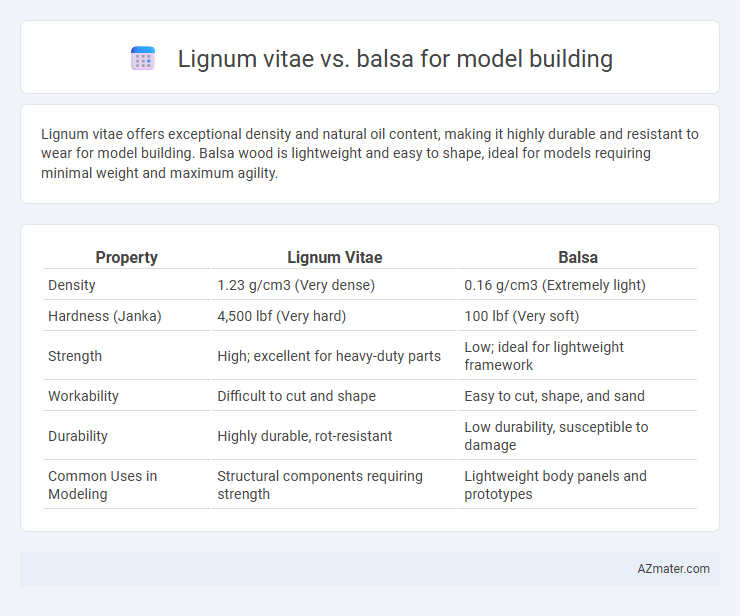Lignum vitae offers exceptional density and natural oil content, making it highly durable and resistant to wear for model building. Balsa wood is lightweight and easy to shape, ideal for models requiring minimal weight and maximum agility.
Table of Comparison
| Property | Lignum Vitae | Balsa |
|---|---|---|
| Density | 1.23 g/cm3 (Very dense) | 0.16 g/cm3 (Extremely light) |
| Hardness (Janka) | 4,500 lbf (Very hard) | 100 lbf (Very soft) |
| Strength | High; excellent for heavy-duty parts | Low; ideal for lightweight framework |
| Workability | Difficult to cut and shape | Easy to cut, shape, and sand |
| Durability | Highly durable, rot-resistant | Low durability, susceptible to damage |
| Common Uses in Modeling | Structural components requiring strength | Lightweight body panels and prototypes |
Introduction to Lignum Vitae and Balsa Wood
Lignum vitae, known for its exceptional density and natural oils, provides unmatched durability and resistance to wear, making it ideal for model building requiring heavy-duty structural components. In contrast, balsa wood, celebrated for its ultra-lightweight and ease of cutting, is preferred in applications where weight reduction and quick shaping are critical. The choice between lignum vitae and balsa wood hinges on balancing strength with weight, directly impacting the performance and longevity of the finished model.
Physical Properties Comparison
Lignum vitae exhibits exceptional hardness, density (around 1.23 g/cm3), and durability, making it highly resistant to wear and ideal for heavy-duty model components. Balsa, with a significantly lower density (approximately 0.1-0.2 g/cm3), offers outstanding lightweight properties and flexibility but lacks the strength and impact resistance of Lignum vitae. The contrasting physical properties, such as Lignum vitae's high Janka hardness (4,500 lbf) versus Balsa's softness (100 lbf), greatly influence material choice in model building depending on structural requirements and weight constraints.
Weight and Density Differences
Lignum vitae, known for its exceptional density of approximately 1.23 g/cm3, is significantly heavier and harder than balsa wood, which typically has a density around 0.1 to 0.2 g/cm3. This substantial weight difference makes balsa the preferred choice for model building where lightweight materials are crucial for flight performance and ease of handling. In contrast, lignum vitae's high density provides superior strength and durability but adds considerable weight, making it less suitable for most model aircraft or delicate structures.
Strength and Durability Analysis
Lignum vitae offers exceptional strength and durability due to its high density and natural oils, making it resistant to wear, moisture, and decay, ideal for heavy-duty model components. Balsa wood, significantly lighter and less dense, prioritizes ease of shaping and weight reduction but exhibits lower strength and durability, often requiring reinforcement in stress-prone areas. Selecting between lignum vitae and balsa depends on the balance between structural integrity and weight constraints essential to the model's performance and longevity.
Workability for Model Builders
Lignum vitae, known for its extreme density and hardness, offers excellent durability but poses significant challenges for model builders due to its difficulty in cutting and shaping, requiring specialized tools and more effort during work. In contrast, balsa wood is highly favored in model building for its lightweight nature and exceptional ease of cutting, sanding, and shaping, allowing for faster construction and fine detailing with minimal tool requirements. While lignum vitae excels in strength and wear resistance, balsa's superior workability makes it the preferred choice for intricate model projects demanding precision and speed.
Cost and Availability
Lignum vitae, known for its density and durability, is significantly more expensive and harder to source compared to balsa wood, which is lightweight, abundant, and affordable. Balsa is widely available from numerous suppliers, making it the preferred choice for model building where cost efficiency and ease of procurement are crucial. The higher price and limited availability of lignum vitae restrict its use primarily to specialized or high-end projects rather than general model construction.
Finishing and Aesthetic Appeal
Lignum vitae offers superior finishing qualities due to its fine grain and naturally oily texture, which provides a smooth, polished surface ideal for detailed sanding and varnishing in model building. In contrast, balsa wood's porous and lightweight structure makes it more prone to surface imperfections, requiring additional sealing for a uniform finish. The dense, dark hues of lignum vitae enhance aesthetic appeal with a rich, natural patina, whereas balsa's pale, soft wood is often painted or coated for visual customization.
Typical Applications in Model Building
Lignum vitae is prized in model building for its exceptional density and durability, making it ideal for components requiring high strength and wear resistance, such as propeller shafts and bearing surfaces. Balsa wood, known for its lightweight and ease of shaping, is commonly used in constructing wing ribs, fuselages, and other aerodynamic structures where minimal weight is crucial. Model builders often select lignum vitae for structural integrity and balsa for weight-sensitive applications to optimize overall performance.
Environmental Impact and Sustainability
Lignum vitae, a dense and slow-growing hardwood, has a higher environmental impact due to its limited availability and deforestation concerns, while balsa wood is highly renewable, known for rapid growth and low ecological footprint. Balsa's ability to regenerate quickly makes it a preferred choice for sustainable model building materials, reducing strain on natural resources. Choosing balsa supports conservation efforts and promotes the use of eco-friendly timber alternatives in hobbyist and professional applications.
Choosing the Right Wood for Your Project
Lignum vitae is an extremely dense and durable hardwood, offering exceptional strength and resistance to wear, making it ideal for high-stress parts in model building. Balsa wood, significantly lighter and softer, allows for easy cutting and shaping, providing excellent buoyancy and flexibility in lightweight model structures. Choosing the right wood depends on balancing the need for strength versus ease of manipulation and overall weight constraints in your model project.

Infographic: Lignum vitae vs Balsa for Model building
 azmater.com
azmater.com